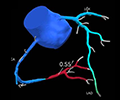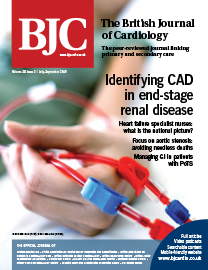Editorials
Clinical articles
News and views
Topics include:-
- Identifying CAD in end-stage renal disease
- Heart failure specialist nurses: what is the national picture?
- Focus on aortic stenosis: avoiding needless deaths
- Managing GI in patients with PoTS

July 2019 Br J Cardiol 2019;26:86–7 doi:10.5837/bjc.2019.023
Angela Graves, Nick Hartshorne-Evans
Abstract

The All-Party Parliamentary Inquiry1 into heart failure reported in September 2016. The inquiry’s aim was to understand what the key issues were in heart failure and what needs to happen to address deficiencies. Data presented to the inquiry highlighted the significant impact of the role played by the heart failure specialist nurse (HFSN). The evidence-base behind the role of the HFSN has shown that these highly skilled individuals have been able to reduce morbidity, mortality and provide patients and carers with holistic and effective care.2 The patients that contributed to the inquiry spoke of the immense support and care that they received from their HFSN. However, further data emphasised that access to a HFSN was inequitable, with anecdotal experience suggesting that services are being decommissioned as a result of reorganisation of services and nurse retirement.
|
Full text
Clinical articles
Back to top
September 2019 Br J Cardiol 2019;26:99–100 doi:10.5837/bjc.2019.028
Anthony P C Bacon, Harry Rosen, Neil Ruparelia
Abstract

The management of aortic stenosis has dramatically changed over the last 60 years. We briefly describe these remarkable advances from the personal perspective of Anthony P C Bacon (APCB) who was one of the first physicians to observe the importance of this pathological process and who watched, first-hand, some of the first surgical aortic valve procedures being performed in the UK. He most recently benefited from treatment with transcatheter aortic valve implantation (TAVI) himself, and provides a personal perspective of his experiences.
|
Full text

September 2019 Br J Cardiol 2019;26:105–9 doi:10.5837/bjc.2019.029
Paul Brady, Andrew Kelion, Tom Hyde, Edward Barnes, Hazim Rahbi, Andy Beale, Steve Ramcharitar
Abstract

 This article is available as a 'Learning with reflection' CPD activity
This article is available as a 'Learning with reflection' CPD activity
In November 2016, the National Institute for Health and Care Excellence (NICE) published an update of its guideline for the investigation of chest pain of recent onset (CG95), bringing computed tomography coronary angiography (CTCA) to the forefront as the first-line investigation. CTCA has a high negative-predictive value for the identification of obstructive coronary artery disease (CAD), but its positive-predictive value may be as low as 48%. Moreover, until recently it was unable to determine the functional significance of stenoses identified by CTCA. Using advanced computational fluid dynamics (CFD), HeartFlow® has pioneered a system that can predict the invasive fractional flow reserve (FFR) from a standard CTCA acquisition (FFRCT). The PLATFORM study has demonstrated that the use of CTCA with FFRCT was associated with equivalent clinical outcomes in terms of major adverse cardiovascular events (MACE) and quality of life at one year compared with usual testing. The global ADVANCE registry, and other long-term follow-up studies in over 9,000 patients, have demonstrated extremely good long-term outcomes when patients with CAD but negative FFRCT are managed conservatively without invasive testing. In a technology appraisal (MTG32), NICE projected that the adoption of this technology within the NHS in England could save at least £9.1 million by 2022. While it is accepted that the HeartFlow® FFRCT shows a lot of promise, there are a number of limitations that need to be considered.
|
Full text
September 2019 Br J Cardiol 2019;26:114–8 doi:10.5837/bjc.2019.030
Amir Orlev, Amna Abdel-Gadir, Graeme Tait, Jonathan P Bestwick, David S Wald
Abstract

Radial artery access coronary angiography is associated with high procedural success and lower rates of complications, compared with femoral access, in patients without prior coronary artery bypass surgery (CABG). Whether or not this applies to patients who have undergone CABG is not known.
We retrospectively examined hospital records of 5,993 consecutive patients undergoing coronary angiography to identify patients with previous CABG undergoing the procedure by the radial or femoral access routes. We compared clinical characteristics, procedural success and complications up to 30 days, adjusting for significant baseline differences.
Among the 5,993 patients undergoing angiography, 471 (8%) had previous CABG; 164 (35%) underwent angiography by the radial and 307 (65%) by the femoral artery. Procedural success was lower in the radial than femoral groups; 28/164 (17%) radial versus 1/307 (0.3%) femoral patients required access-site cross-over (p<0.001) and 254/347 (73%) versus 496/594 (84%) bypass grafts were selectively identified without the need for further imaging investigations (p=0.008), respectively. Access-site bleeding requiring compression affected 1/164 (0.6%) in the radial group and 12/307 (3.9%) in the femoral group (p=0.04 for difference) with no significant differences in other major complications.
About one in 12 patients undergoing coronary angiography have had previous CABG surgery. In such patients, the radial access route was associated with lower procedural success than the femoral route but also a lower rate of bleeding complications.
|
Full text
September 2019 Br J Cardiol 2019;26:119 doi:10.5837/bjc.2019.031
Nicolas Buttinger, Mark Forde, Timothy Williams, Sally Curtis, James Cockburn
Abstract

We describe a case of primary meningococcal Y effusive pericarditis in a previously fit and well 35-year-old man who presented with a rapidly developing pericardial effusion resulting in cardiac tamponade. This is a rare, but important, cause of primary pericardial disease, and only the fourth documented case of primary meningococcal pericarditis due to Neisseria meningitidis serotype Y. Our patient was successfully treated with a pericardial drain and intravenous ceftriaxone. Our case highlights the importance of adverse clinical features such as temperature >38°C, subacute course, large effusion or tamponade, and non-steroidal anti-inflammatory drug (NSAID)/aspirin failure, which can identify patients who require close observation as they are at higher risk of complications.
|
Full text
July 2019 Br J Cardiol 2019;26:110–3 doi:10.5837/bjc.2019.024
Matthew E Li Kam Wa, Pitt O Lim
Abstract

Angiography of internal mammary artery (IMA) grafts continues to be a common indication for upfront femoral access. This is particularly the case for bilateral pedicled IMAs, or when the left radial artery has been grafted. While the right radial artery is ideally suited in these situations for cannulation of the right IMA, accessing the left IMA (LIMA) by this route is often perceived as challenging and for ‘radial evangelists’ only. We describe a case series showing a simple technique for selective cannulation of the LIMA from the right radial artery using a single catheter that provides sufficient backup for percutaneous coronary intervention (PCI).
|
Full text
July 2019 Br J Cardiol 2019;26:101–4 doi:10.5837/bjc.2019.025
Jeremy S Nayagam, Viral A Sagar, Maxwell Asante
Abstract

Gastrointestinal (GI) symptoms are common in patients with postural orthostatic tachycardia syndrome (PoTS). Our understanding of managing GI symptoms in PoTS is very limited. Our objectives were to evaluate common GI symptoms, diagnostic work-up, diagnosis and management strategy in patients with PoTS.
We retrospectively reviewed medical records of all patients referred to the gastroenterology clinic (2014 to 2017) with GI symptoms and known or suspected PoTS: 85 patients with PoTS and GI symptoms were seen in our clinic. Bloating (75%), constipation (74%) and abdominal pain (60%) were the most common GI symptoms. Endoscopy, high-resolution manometry, gastric-emptying studies and colonic-transit studies were commonly performed investigations. Over two-thirds of patients had confirmed or suspected GI dysmotility, 5.9% had organic GI disease (e.g. inflammatory and acid peptic disorders).
In conclusion, the majority of patients with PoTS have a functional disturbance and reduced GI motility, however, a small proportion have organic disease that needs systematic evaluation. Dietary modifications and laxatives are the main modalities of therapy.
|
Full text
July 2019 Br J Cardiol 2019;26:92–6 doi:10.5837/bjc.2019.026
Subodh R Devabhaktuni, Ali O Malik, Ji Won Yoo, Xibei Liu, Vipul Shah, Syed I Shah, John M Ham, Bejon T Maneckshana, Jimmy Diep, Chowdhury H Ahsan
Abstract

False-negative results either from balanced ischaemia or from failure to induce optimal hyperaemia is a known limitation of vasodilator myocardial perfusion imaging (MPI). We sought to identify the prevalence of false-negative results in the kidney transplant population and to identify the risk factors predictive of false-negative MPI results at our institution.
We retrospectively studied 133 consecutive patients who were referred to us for pre-operative evaluation. Mean age was 56 years and 70% of the subjects were males. All patients who underwent vasodilator MPI and computed tomography coronary angiography (CTCA) were included.
In the studied population, false-negative vasodilator MPI test result prevalence was around 13%. In uni-variable and multi-variable analysis, diabetes and cardiovascular disease (CVD) were predictive of false-negative vasodilator MPI testing results. CTCA had a positive-predictive value (PPV) of 82%.
In conclusion, false-negative results, either from balanced ischaemia or from failure to induce optimal hyperaemia, are a major problem in the pre-operative evaluation of renal transplant patients when the vasodilator MPI test is used. CTCA could be a useful imaging modality in this patient population. We found that diabetes and CVD are significantly associated with false-negative MPI results.
|
Full text
July 2019 Br J Cardiol 2019;26:120 doi:10.5837/bjc.2019.027
Jenny McKeon, Richard Mansfield, Mark Hamilton, Benjamin J Hudson
Abstract

Absence of the pericardium is a rare defect that can be both congenital and acquired. Defects occur through abnormal development of the pleuro-pericardial membranes, which should fuse at the midline and separate the pericardial and pleural cavities.1 Congenital incidence is thought to be less than one in 10,000,2 however, prevalence is uncertain due to the incidental findings of many diagnoses. With increasing use of cardiac magnetic resonance imaging (CMR) and cardiac computed tomography (CT), diagnosis of pericardial absence is becoming more frequent, however, little is known about the long-term management of these patients.
|
Full text
April 2019 Br J Cardiol 2019;26:97–8 doi:10.5837/bjc.2019.015
John B Chambers
Abstract

Echocardiography is key for the assessment of aortic stenosis (AS), but taking a good history is also crucial and requires specialist competency. Symptomatic AS requires surgery and, if physicians miss the onset of symptoms, the risk of death rises from 1% per annum in patients without symptoms to 14% on a six-month surgical waiting list. A case is described illustrating the difficulty of obtaining the history in a patient with AS, and suggests how to take a careful history and questions to ask. Patients with a murmur suggesting AS should be considered for a specialist valve clinic.
|
Full text
News and views
Back to top

September 2019 Br J Cardiol 2019;26:88–9
With recent developments in medications and their clinical implications, the worlds of both diabetes and cardiology were focussed on the American Diabetes Association...
September 2019 Br J Cardiol 2019;26:90
‘The heart failure multidisciplinary team’ was the theme for the 21st Annual Autumn Meeting of the British Society of Heart Failure (BSH), which...
September 2019 Br J Cardiol 2019;26:91
We are delighted to welcome two new editorial board members to The British Journal of Cardiology: Drs C Michael Gibson and Amar...





